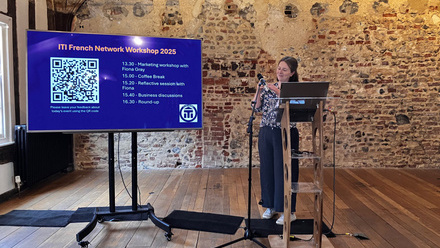Taking the plain
Zosia Niedermaier-Reed and Kate Sotejeff-Wilson explain plain English for translators: why we need it, how to do it, and who to learn from.
The aim of plain language is simple: to help readers. It allows more people to access information. And as translators, we need to be aware of how plain language is being used more and more in both our source and target languages.
Why do we need plain English?
Plain English makes texts easier for everyone to understand, including non-native speakers, native speakers and people with reading problems and/or learning difficulties. The more understandable a text is, the more effective it is.
In our field, it’s particularly important to think about the language we use when we write texts for an international audience. In fact, all clinical trials in the EU will soon require a plain language summary so that all the participants can understand what is happening.
Last October, Zosia attended the Clear Writing for Europe 2021 conference. Speakers discussed the importance of providing clear language in a variety of contexts; and in her welcome address, European Ombudsman Emily O’Reilly pointed out that governments that had not provided clear information on Covid had been unable to guarantee their citizens’ support, leading to increased distrust in government and trust in fake news – especially since ‘fake news’, by contrast, is often conveyed in very clear language which people can easily understand. Plain language is vital for getting messages across.
How do you write in plain English?
Here are some of the techniques we try to use when editing in plain English or translating a text into plain English:
- Avoid phrasal verbs: instead of ‘look up’, try ‘search’.
-
Avoid similes and metaphors, unless the meaning is very obvious: instead of ‘sleep like a log’, try ‘sleep well’.
-
Avoid ellipses – this is when the writer doesn’t include words that native speakers can easily infer: instead of ‘the square is shown dashed in picture 2’, try ‘the square is shown using dashed lines in picture 2’.
-
Use simpler synonyms: instead of ‘objective’, try ‘goal’.
-
Use the active voice – readers will understand your sentence more easily if it is clear who is doing what: instead of ‘the members are chosen by the organisation’, try ‘the organisation chooses the members’.
-
Use a maximum of 20 words in any sentence – try cutting longer sentences into two or more.
-
Avoid complex sentence structures.
-
Use lists and bullet points where possible to help communicate information more clearly.
What about other languages, like Polish?
It is worth looking at how people are making your source language plainer, as well as the differences between plain language and easy-to-read language (see Brigitte Meile’s excellent article on Easy German in the September-October 2021 Bulletin). Many of the principles are the same for other languages as well, but each language has its own features. We recently learned how it worked for our shared source language, Polish.
In a workshop for the ITI Polish Network last autumn, Dr Tomasz Piekot explained how plain Polish works, how it developed, and how to use it, with plenty of practical examples. Dr Piekot has more than a decade of experience in making Polish texts plainer, and researching the methods for doing it in the Plain Polish Workshop at the University of WrocÅaw. His presentation led to a lively discussion about our own practices and how we can make our translations plainer, and it covered hot topics like simplification, anglicisms and the language to express race, gender and other aspects of identity.
Dr Piekot recommended several techniques that could work for your source language, too. One great tip is to organise information visually, using images, symbols, text boxes, subheadings and timelines. Another is to avoid using jargon (which Piekot delightfully called abracadabra words – for example, anglicisms). He also gave word limits: a maximum of 10 words per sentence is enough for mobile, 15 for web, 20 for paper.
Show and tell: plain English and some of the many contexts where it works, written in plain English
1. Plain English is flexible. You just need to ask: ‘what do I want to say?’ and ‘who am I writing for?’
2. Plain English takes the readers seriously. How often do people say ‘that’s too difficult to read’?
3. Plain English is interesting. You can vary it. Complicated, official language can be more boring!
4. Plain English can be hard work. You need to check words and sentence length, plan, and test. But it is worth it!
5. Plain English is faster and cheaper. It takes time at the beginning but eventually saves time and money. If your text is clear, you don’t need to explain it.
6. Plain English works for sharing complex ideas. What you say is not simple, but the way you say it is clear.
7. Plain English works for formal writing. A clear message sounds stronger than a complicated one.
8. Plain English works for university. Researchers can reach more people if they explain their ideas well.
9. Plain English works for law. People find it easier to keep and enforce clear laws.
10. Plain English is useful for reaching readers. You can use it to give many people large amounts of information.
Where can I learn more?
Kate did the Chartered Institute of Editing and Proofreading (CIEP) course on ‘Plain English for Editors’ and thoroughly recommends it. She learned that technology can help make your English plainer. You can customise grammar checks in Word, use macros, and make PerfectIt style sheets. She also tried some software. StyleWriter highlights words that ‘bog’ a text down and ‘pep’ a text up, making it harder or easier to read. Online, you can use the Hemingway Editor for free. But all these tools have their limits.
There are also some excellent online guides from organisations including the Plain English Campaign; the Center for Plain Language (in the US); the UK Government website; the UK Association for Accessible Formats; the National Institute for Health and Care Excellence; the Financial Times; and University College London’s Institute of Education. But you won’t absorb everything about plain English by visiting the websites. On the CIEP course, you do exercises and can talk to your tutor or other students.
And above all, the best way to write in plain English is to try it and see what real readers think. They will tell you whether they understand or not.
Mentoring and learning together
We have been working together on the issue of clear language for some time now. Zosia wrote her MA dissertation on plain language, and Kate mentored her on translation from Polish to plain English, editing in English and telling clients that she offers this service.
We met between March and October 2021. For our first session Zosia had translated an extract from the Polish version of an EU guide to clear writing. We then revised the translation in plain English, and then checked this against the English version of the guide. For our second session, Zosia edited a Wikipedia article about Mexican history in simple English. Zosia also wrote two articles about plain English for the Polish Network newsletter. In our third session, we shifted focus from telling colleagues about plain English to telling clients. We worked on copy for emails, social media profiles and her website.
We didn’t stop there – we wrote this article together and joined the PLAIN network. We’ll continue to share our passion for plain language, and we hope you share it now, too.
This article first appeared in the March-April 2022 edition of ITI Bulletin
Zosia Niedermaier-Reed is a Polish, Russian and Spanish to English freelance translator living in Bristol, UK. She believes that everyone should have access to information in a language they can understand. Zosia is currently focusing on plain English.
Dr Kate Sotejeff-Wilson MITI is an advanced professional member of the CIEP. Born in Wales, she lived in Poland and Germany, and is now in Finland. She translates, copywrites and edits for academics, and is happiest in the space between languages, reading or on writing retreats.
Never miss another Bulletin article

If you would like to read more features and articles on a wide variety of subjects relating to all aspects of the translation and interpreting industry, subscribe to ITI Bulletin. Alternatively, join ITI and get a free subscription included in your membership.






